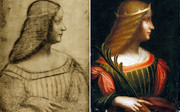
Senior Member

- Group
- pope
- Posts
- 37,198
- Status
- Anonymous
|
| |

CITAZIONE
Scientific tests suggest that the oil portrait is indeed the work of da Vinci, according to Carlo Pedretti, a professor emeritus of art history and an expert in Leonardo studies at the University of California, Los Angeles.
“There are no doubts that the portrait is the work of Leonardo,” Prof Pedretti, a recognised expert in authenticating disputed works by Da Vinci, told Corriere della Sera newspaper.
“I can immediately recognise Da Vinci’s handiwork, particularly in the woman’s face.”
Tests have shown that the type of pigment in the portrait was the same as that used by Leonardo and that the primer used to treat the canvas on which it was painted corresponds to that employed by the Renaissance genius.
Carbon dating, conducted by a mass spectrometry laboratory at the University of Arizona, has shown that there is a 95 per cent probability that the portrait was painted between 1460 and 1650.
But there needs to be further analysis to determine whether certain elements of the portrait — notably a golden tiara on the noblewoman’s head and a palm leaf held in her hand like a sceptre — were the work of Leonardo or one of his pupils, Prof Pedretti said.
A likely contender would be Gian Giacomo Caprotti, nicknamed Salai, who began working with Leonardo as a child and is believed to have become his lover. [...]
The newly discovered portrait, which measures 24in by 18in, does bear a striking similarity to the Leonardo sketch held by the Louvre — the woman’s posture, her hairstyle and her dress are almost identical, while her enigmatic smile recalls that of the Mona Lisa.
Martin Kemp, professor emeritus of the history of art at Trinity College, Oxford, and one of the world’s foremost experts on da Vinci, said if the find was authenticated it would be worth “tens of millions of pounds” because there are only 15 to 20 genuine da Vinci works in the world.
But he raised doubts about whether the painting was really the work of Leonardo.
The portrait found in Switzerland is painted on canvas, whereas Leonardo favoured wooden boards.
“Canvas was not used by Leonardo or anyone in his production line,” Prof Kemp told The Daily Telegraph. “Although with Leonardo, the one thing I have learnt is never to be surprised.”
There are further doubts – Leonardo gave away his original sketch to the marquesa, so he would not have been able to refer to it later in order to paint a full oil version.
“You can’t rule out the possibility but it seems unlikely,” Prof Kemp said.
It was more likely to have been produced by one of the many artists operating in northern Italy who copied Leonardo’s works.
telegraph

CITAZIONE È lì, rinchiusa in un caveau svizzero, con una corona in testa e una palma impugnata come uno scettro, dettagli quasi certamente aggiunti dagli allievi «più affezionati» (Salaì e Melzi) che il maestro portò con sé a Roma nel 1514. Isabella d’Este, addobbata come fosse santa Caterina d’Alessandria, aspetta di entrare, per la prima volta da quando la dipinse Leonardo, in un museo.
La sua storia - ricostruita in esclusiva da «Sette» - ha gli ingredienti di un thriller. Con buone probabilità di approdare a un epilogo positivo. Era cominciata con un cartone preparatorio (conservato al Louvre) abbozzato da Leonardo nel 1499 durante un soggiorno a Mantova, ospite dei Gonzaga; negli anni successivi, più volte la marchesa inviò lettere e ambasciatori implorando che lo schizzo venisse trasformato «de colore», ma nulla di più, salvo l’«avvistamento», nel 1517, del ritratto di una signora lombarda nel castello di Blois. Poi, un silenzio «assordante» che ha prodotto fiumi d’inchiostro e la conclusione, di sconsolati studiosi, che forse il quadro non era mai stato realizzato o che Isabella non foss’altro che la Gioconda: Mona Lisa, ovvero Mona l’Isa (bella). Tre anni e mezzo fa, infine, il ritratto è riemerso dall’eredità di una famiglia che vive, dagli inizi del Novecento, tra il Centro Italia e la Svizzera, a Turgi, nel cantone Argovia. [...]
In questi tre anni e mezzo, oltre ai documenti che riportiamo su «Sette», sono stati fatti altri accertamenti scientifici. Il primo, realizzato grazie a tre prelievi dall’opera, ha dimostrato che i pigmenti sono esattamente quelli utilizzati da Leonardo; il secondo, che l’imprimitura della tela è preparata secondo la ricetta scritta da Leonardo nel suo Trattato; infine, la cosa più stupefacente: la fluorescenza ha fatto riapparire, davanti alla mano, il libro, simbolo di Isabella protettrice di Lettere e Arti, presente nel cartone del Louvre. Ora si apre il dibattito sull’autenticità del dipinto. Se, come tutte le ricerche sembrano attestare, il ritratto è stato realizzato da Leonardo e poi ultimato dai suoi allievi, potrebbe cambiare un pezzo significativo della Storia dell’Arte.
tutto sul corriere.it
Edited by ‚dafne - 5/10/2013, 00:24
|
|
 CITAZIONEÈ lì, rinchiusa in un caveau svizzero, con una corona in testa e una palma impugnata come uno scettro, dettagli quasi certamente aggiunti dagli allievi «più affezionati» (Salaì e Melzi) che il maestro portò con sé a Roma nel 1514. Isabella d’Este, addobbata come fosse santa Caterina d’Alessandria, aspetta di entrare, per la prima volta da quando la dipinse Leonardo, in un museo.
CITAZIONEÈ lì, rinchiusa in un caveau svizzero, con una corona in testa e una palma impugnata come uno scettro, dettagli quasi certamente aggiunti dagli allievi «più affezionati» (Salaì e Melzi) che il maestro portò con sé a Roma nel 1514. Isabella d’Este, addobbata come fosse santa Caterina d’Alessandria, aspetta di entrare, per la prima volta da quando la dipinse Leonardo, in un museo.




